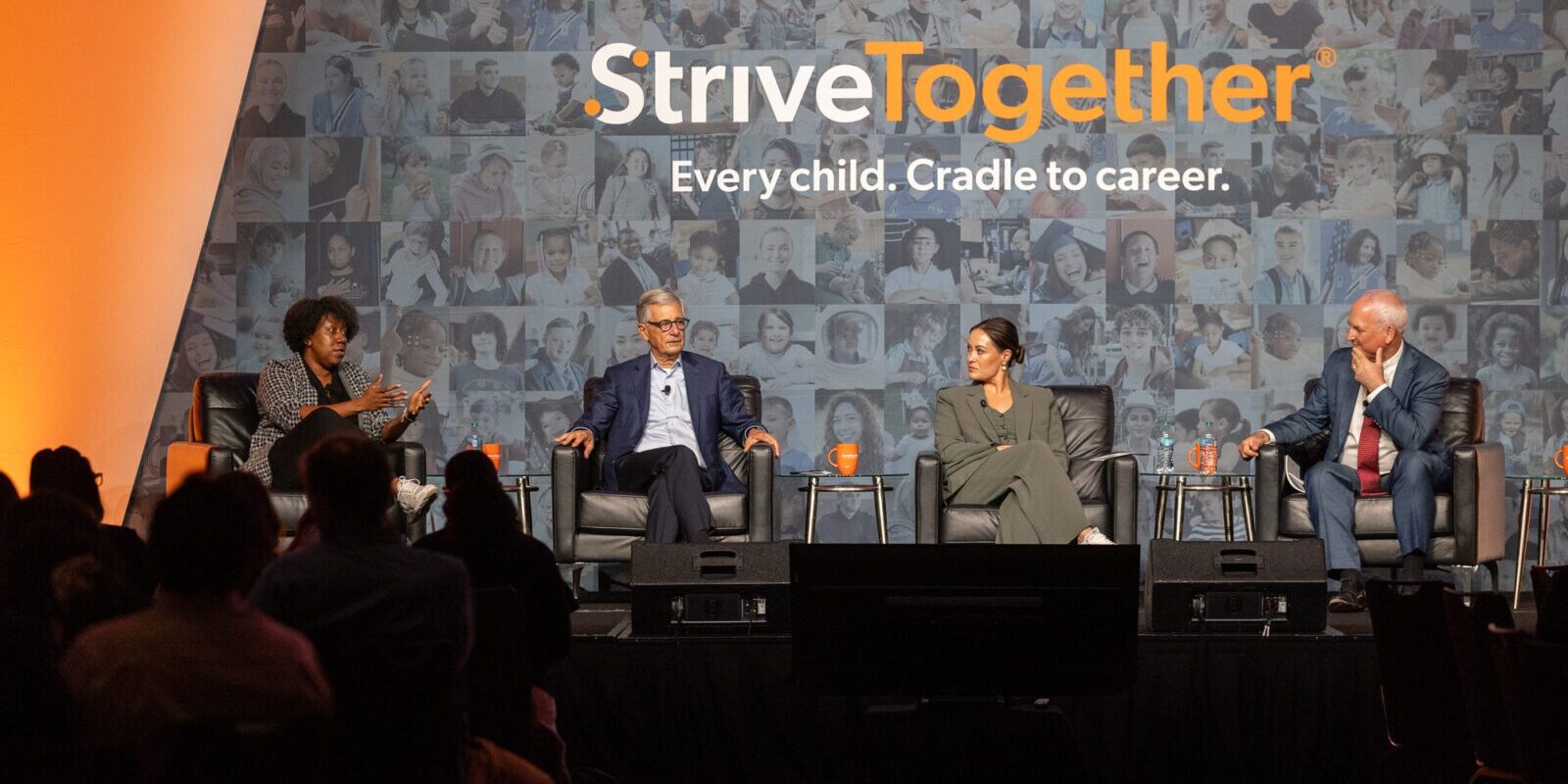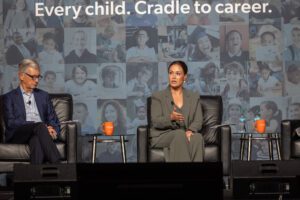We are living through both challenges and extraordinary possibility. There are millions of open jobs across the country, yet nearly half of full-time workers aren’t earning a living wage. That disconnect shows up in the lived experience of families in every zip code. It is also our invitation to act together.
Workforce development is a community-wide movement that lifts everyone — families, employers and leaders across parties who want to see their communities thrive.
In a powerful panel at the 2025 Cradle to Career Network Convening, we explored how place-based partnerships can align education, workforce and policy to meet the demands of a changing economy.
Our discussion brought together Terri-Ann Brown, director of Miami Tech Works; Stephen Goldsmith, professor at Harvard Kennedy School and director of Data-Smart City Solutions at Harvard University; and Lieutenant Governor Jacqueline Coleman of Kentucky. Jon Schnur, CEO of America Achieves, moderated to address both the urgency and optimism of workforce opportunities. What follows are my reflections — what I heard, what I learned and what I believe comes next for StriveTogether and our network.
1) The moment we’re in: opportunity, speed and shared stakes
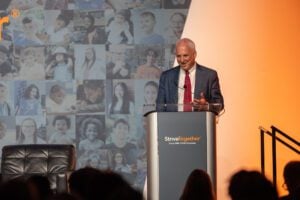
As Jon Schnur opened the plenary, he framed the challenge directly: “Employers are hiring and changing faster than our systems were built to adapt.” Roles in advanced manufacturing, cybersecurity, clean energy and technology now require skills that shift in months, not years.
At the same time, Schnur reminded us that the basics matter more than ever: “If you don’t know how to read deeply or write well, you won’t be able to leverage AI or keep up with the demands of a rapidly changing economy.” Strong foundations in reading, math and problem solving remain essential, even as technical skills evolve at an unprecedented pace.
Artificial intelligence only heightens this reality. It raises the demand for strong fundamentals while accelerating the speed at which technical competencies change. That’s why so many young people feel anxious about the future, even as “Help Wanted” signs multiply. The pathway from classroom to credential to career is still too often unclear, fragmented and slow. Students and workers can’t see where the road leads, and employers can’t find the talent they need.
StriveTogether’s Cradle to Career Network takes on these challenges head on, showing how local partnerships create lasting pathways from school to work. We align around shared outcomes, use data to adapt in real time, and bring together partners who don’t usually sit at the same table. Most important, this work builds broad coalitions — employers, workers, parents and students, joined by leaders across the aisle, united around one outcome: jobs that open doors to opportunity and growth.
2) What works: place-based partnerships that connect education to good jobs
Our panelists offered concrete, homegrown solutions that are working right now.
Lieutenant Governor Jacqueline Coleman described how Ford’s historic EV battery investment in Glendale, Kentucky, required a bold talent solution. The state partnered with Ford and the Kentucky Community and Technical College System to build a state-of-the-art training facility on campus. As she put it, “No one can do this kind of work by themselves. It takes business, education and government working in lockstep.”
This training facility is part of a broader wave of growth in Kentucky. Since Governor Beshear and Lt. Governor Coleman took office, the state has announced more than $40 billion in economic development projects, creating over 70,000 new jobs. These investments will only be sustainable if the talent pipeline is ready, which is why partnerships with education and training systems are essential.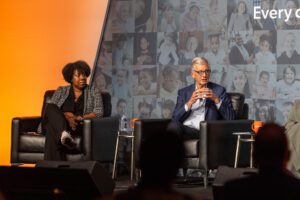
Stephen Goldsmith reminded us that what we often call “the workforce system” is really a set of disconnected systems — employers, colleges, unions, nonprofits and governments — often speaking different languages about skills. “There is no single workforce system,” he said. “Intermediaries have to play quarterback so the pieces don’t drift apart.” In communities across the country, local partnerships are stepping into that role, translating employer demand into shared definitions and building data platforms that make pathways visible to learners.
Terri-Ann Brown shared how Miami Tech Works used a Good Jobs Challenge grant to launch the Tectonic Coalition, a sector partnership led by employers. “Our goal was simple: let employers lead in defining the skills they need and make sure training providers respond in real time,” she said. By keeping employers in the driver’s seat, Miami ensures that local residents benefit from the city’s tech boom rather than being left behind.
Across these examples, the lesson is clear: communities can move quickly without sacrificing quality. When partnerships focus on outcomes, align around shared definitions and build on local trust, they create pathways that make sense for both employers and families.
3) Data and dignity: building transparent, human-centered pathways
Jon Schnur reminded us that “data is not boring when it changes lives.” Shared, usable data is a key technical ingredient that separates promising pilots from durable systems. It helps answer critical questions:
- Learners and workers need to see, “If I invest in this credential, what job can I access and what will it pay?”
- Training providers and colleges need to know whether programs are producing the competencies employers hire for.
- Employers need confidence that posted skill demands match what partners are teaching and a fast way to update those needs.
- Policymakers need evidence of what actually moves wages and placement so public dollars scale what works.
Without a shared language, the pieces don’t connect. That’s why place-based partnerships and state policy are so critical. They provide the backbone for alignment.
Lieutenant Governor Coleman underscored the human side of the work: “A seamless pathway includes child care, transportation and other wraparound services as essential infrastructure, not extras.” Workforce strategies fail when they ignore the realities of people’s lives. Our network equips communities to take on both. We sustain cradle-to-career outcomes while extending that discipline to the transitions from high school to credentials to good jobs, with early foundations still at the center.
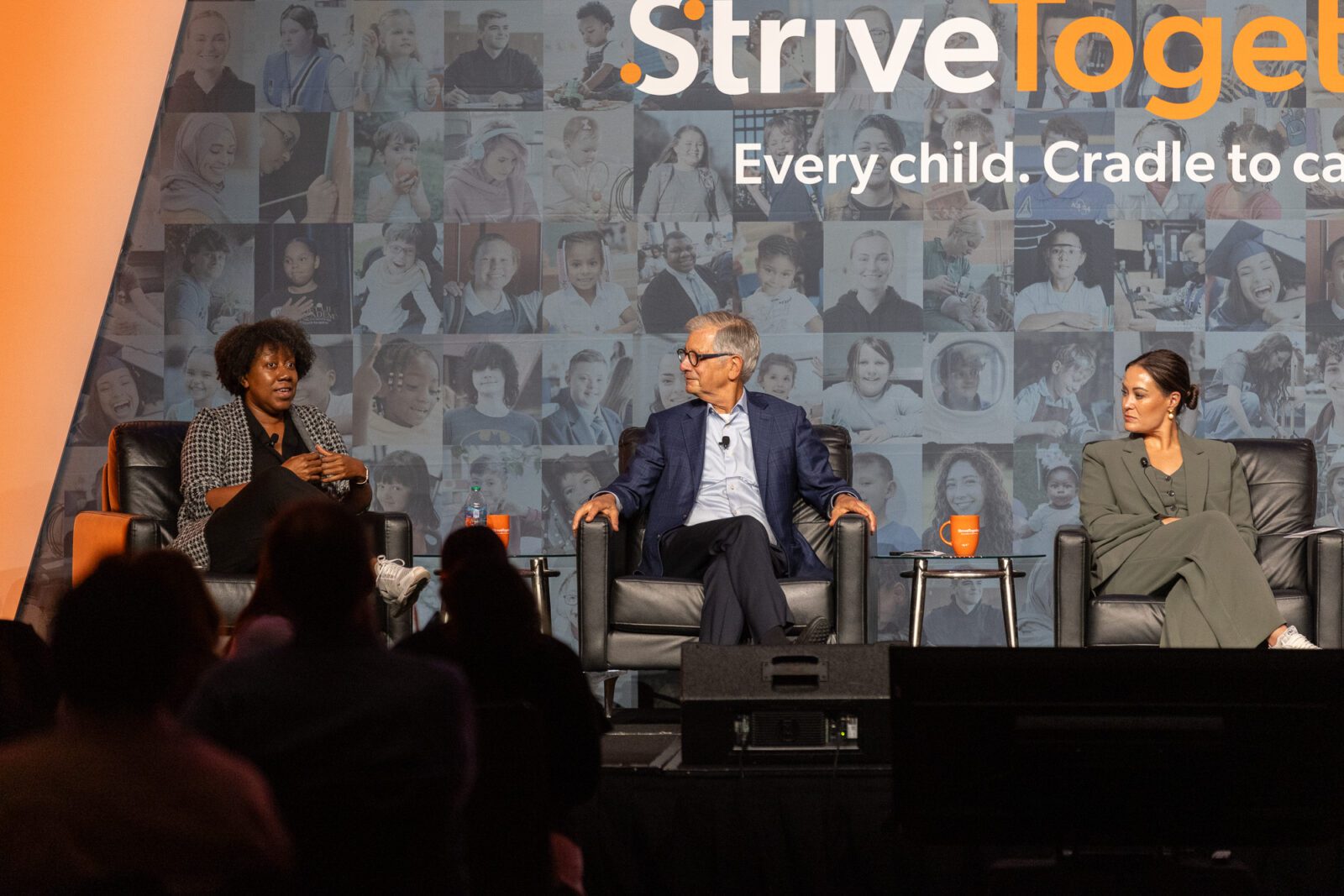 4) The path forward: scale what works, together
4) The path forward: scale what works, together
As I think reflect on what comes next, I believe we need to double down on the basics that emerged in our conversation:
- Strengthen a community anchor. Every community needs a trusted intermediary with the responsibility to align skills language, bring employers to the table and manage shared data. This anchor might sit within your partnership, in a specialized organization or with a trusted ally.
- Make skills visible. Build a shared, region-wide skills framework with employers and map credentials and courses to those skills. Publish simple guides for learners that show time, cost, supports available and likely wage outcomes.
- Design for speed and supports. Offer short, stackable pathways that ladder into degrees and good jobs. Bundle child care, transportation, advising and stipends as standard features, not special programs.
- Commit to wage-based outcomes. Track and report placement into self-sufficient wage jobs by race, ethnicity and zip code. Use those results to improve and to advocate for policy and investment.
- Grow the coalition. Treat employer engagement as a practice. Keep workforce alignment top of mind with regular convenings, clear data stories and public commitments across business, postsecondary, K–12 and government.

This is a moment of urgency and readiness. Our partnerships have spent years building the muscles that matter: outcome focus, data discipline, cross-sector trust and the staying power to orchestrate complex work. The opportunity now is to scale locally through strong community anchors and statewide through enabling policy that supports shared data, stackable credentials and funding tied to equitable, living-wage outcomes. From Kentucky’s battery belt to Miami’s tech corridors, communities are showing what’s possible when education and employment align with people’s real lives.
As Lt. Governor Jacqueline Coleman reminded us, “Now it’s time to look further into the future. It’s not just economic development or workforce development. It is human development.” Her words capture why this work matters and why our network is committed to scaling what works. Workforce development fuels economic growth and strengthens human potential. When we commit to both, we expand opportunity, stability and hope. That is the promise of this work, and our network is moving it forward to ensure millions more young people are on the path to economic mobility.

